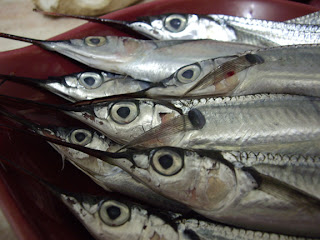 "Ano ho'ng tawag, diyan?"
"Ano ho'ng tawag, diyan?""
Bugyo. Flying fish."
"Ano ho'ng luto diyan?""Paksiw. Saka prito."
"Sige, pabili nga ho ng kalahati. Pero wag n'yong putulin yung nguso, para makita ng mga anak ko."I do not trust myself with buying fish. Checking for freshness, what's good for what isn't exactly my forte, and so it is my husband who buys fish. But it isn't always that I see this fish at the wet market in Pacita Complex, and I knew the find would be news to my husband:
"Wow! Saan ka nakakuha niyan?""Sa Pacita. Ano'ng tawag sa inyo nito?"
"Bangsi. Flying fish yan e.""Sabi nga sa akin."
And so he fried up the bugyo/bangsi/flying fish while I cooked up the monggo.
I remember the story of one classmate who, according to lore, sauteed monggo beans straight up -- sans pre-broiling-- and invented the first ever
chunky Monggo Guisado. I heard of one story too where another beginner made ginisang monggo with what seemed like a
balde (pail) of
sabaw. And so while I trust you are all adept *kitcheners,* (kusineras -- hehehe) I'd have to post the recipe for those who need a tip or two.

Tip #1: To save on gas and to shorten cooking time, wash then soak monggo beans in water for at least 30 minutes before boiling. You can do the soaking in the same pot where you intend to boil the beans. (Better if you can soak for 2 to 3 hours prior.)
Tip #2: Boil the monggo beans to soften them before sauteeing. If you've soaked the beans for at least 30 minutes, boiling time would be about 15-20 minutes. The beans are soft if the seed coat separates from the seed.
Tip #3. Do NOT boil monggo seeds in your pressure cooker.
Tip #4. They MULTIPLY exponentially. So do not cook a lot unless you intend to eat monggo for one whole week or feed a whole baranggay. One cup (about P10.00) feeds 6 to 8.
Tip #5. To pre-boil the beans, use 4 cups of water for every cup of monggo beans.
Tip #6. The green ones work best. Although some swear by the yellow ones. As for me, the red variety is strictly for hopia. ;)
GINISANG MUNGGOWhat's In It?
3 T cooking oil
1 large onion, peeled and sliced
1 medium ripe tomato, washed and sliced
5 cloves garlic, minced
1 cup (about 80 g.) green monggo, pre-boiled
50g.
hibe (dried shrimps),
optional50g. pork pigue, diced*
2 to 3 pcs.
tinapa (smoked fish), scaled and flaked
4 to 5 cups water
1 bunch
ampalaya (bitter gourd) tops, washed, leaves separated from vines (optional)
patis (fish sauce) to taste
Kitchen Conjugations:
Heat oil in a wok or deep pan. Saute onions, garlic and tomatoes for one minute. Add in pork and stir fry until lightly browned. Stir in hibe, tinapa, pre-boiled monggo beans and patis. Cover and simmer for 5 minutes over low fire.
Add in water and let simmer for another 5 minutes to allow the ingredients to meld. Top with ampalata tops and let simmer for half a minute or until the leaves change color. Serve with fried fish and steamed rice.
---------
*or use 1 pork broth cube or 50 g. chicharon
 Acquired tastes -- the hallmark of growing old. Once upon a time, I hated finding in my lunch box a jar of guyabano shake/juice which well-meaning mom made for me. Seven, eight years old, and your beverage world is all about Tang.
Acquired tastes -- the hallmark of growing old. Once upon a time, I hated finding in my lunch box a jar of guyabano shake/juice which well-meaning mom made for me. Seven, eight years old, and your beverage world is all about Tang.




